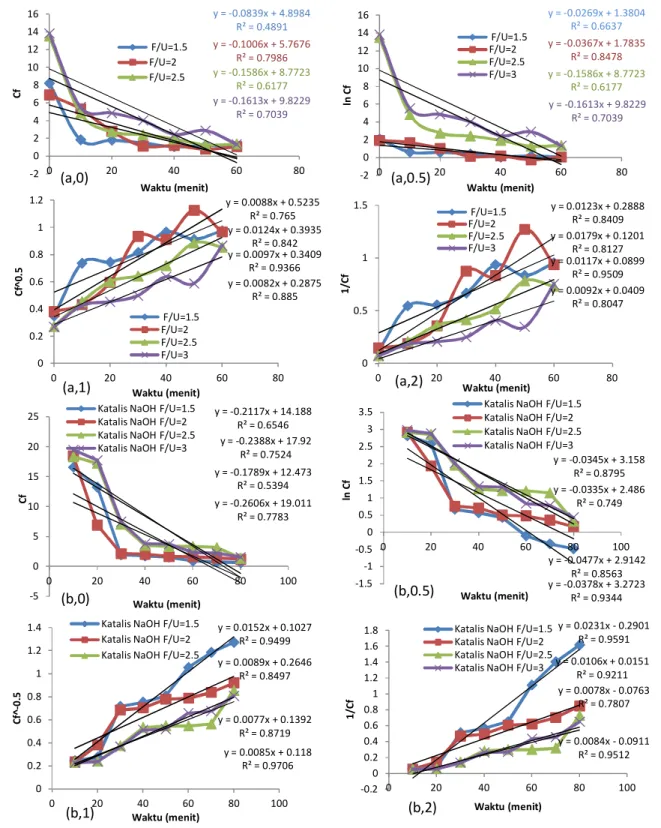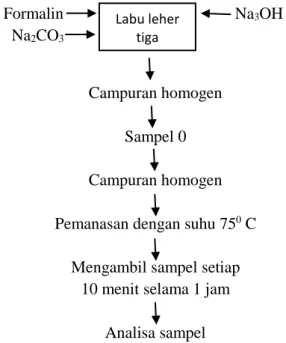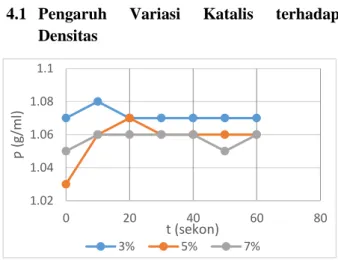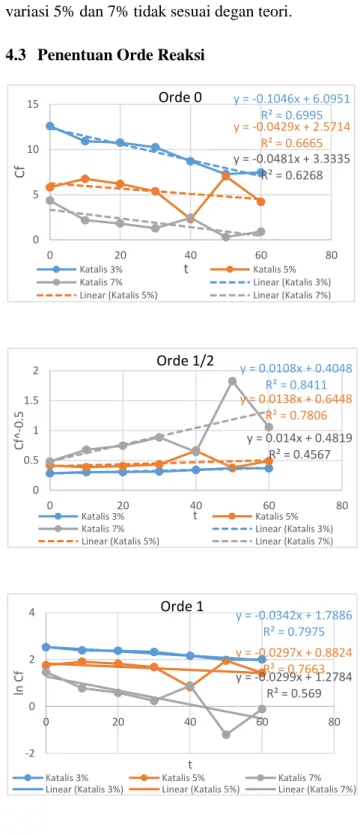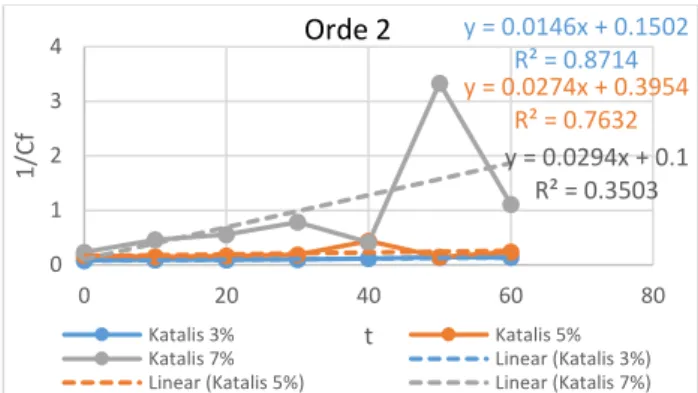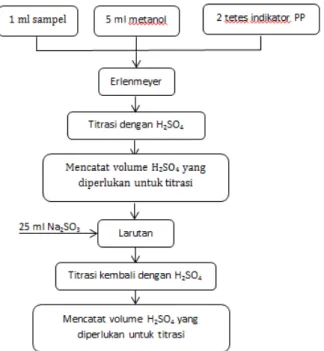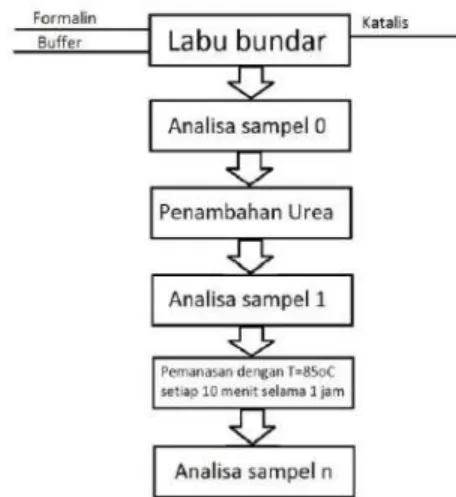REVISI PEMBAHASAN
Pengaruh Waktu Reaksi Terhadap Densitas
Pengaruh Waktu Reaksi Terhadap Viskositas
Berdasarkan jurnal berjudul “Pengaruh Rasio Reaktan dan Jumlah Katalis Terhadap Konversi Minyak Jagung Menjadi Metil Ester” dijelaskan bahwa penggunaan katalis untuk mempercepat laju reaksi harus mempunyai perbandingan yang sesuai dengan bilangan tersebut. dari reaktan yang digunakan. Apabila perbandingan yang digunakan antara reaktan dan katalis tidak tepat maka akan mempengaruhi hasil konversi pada saat reaksi berlangsung. Oleh karena itu, untuk mendapatkan hasil konversi terbaik dalam proses reaksi, reaktan dan katalis yang digunakan harus memiliki perbandingan yang sesuai.
Berdasarkan jurnal yang berjudul “Pengaruh Waktu Pencampuran Pada Proses Pencampuran Asam Poli Laktat dengan Polyethylene Glycol-400 Terhadap Viskositas dan Densitas Bioplastik” dijelaskan bahwa pada suatu reaksi yang dilakukan dengan pencampuran yang konstan dari awal sampai akhir, maka semakin lama waktu yang dibutuhkan. waktu reaksi, semakin banyak produk yang terbentuk. Jadi, jika waktu reaksi semakin lama, maka resin urea formaldehida yang terbentuk akan semakin banyak. Berdasarkan Gambar 4.2 grafik analisis viskositas dapat disimpulkan bahwa variasi massa katalis yang terbaik adalah variasi massa katalis sebesar 2% dari total massa reaktan.
Hal ini disebabkan perubahan massa katalis 1% dan massa katalis 3% tidak mempunyai perbandingan yang sesuai dengan massa total reaktan sehingga mempengaruhi konversi pada saat reaksi.
Penentuan Orde Reaksi
Hal ini menunjukkan bahwa reaksi yang berlangsung merupakan reaksi yang lajunya dipengaruhi oleh konsentrasi dua reaktan yang berbeda dan dipangkatkan satu.
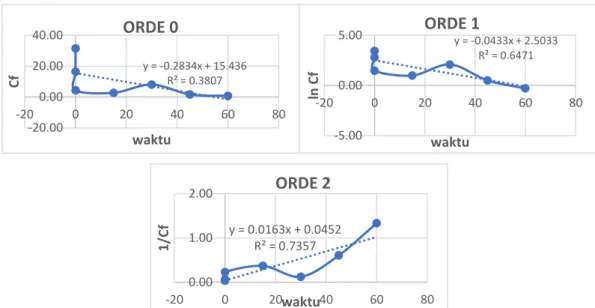
Identification of the substance/mixture and of the company/undertaking
- Product identifier
- Relevant identified uses of the substance or mixture and uses advised against
- Emergency telephone number
Hazards identification
- Classification of the substance or mixture GHS-US classification
- Label elements GHS-US labelling
- Unknown acute toxicity (GHS-US) No data available
P264 - Wash exposed skin thoroughly after handling P270 - Do not eat, drink or smoke when using this product P271 - Use only outdoors or in a well-ventilated area. P272 - Contaminated work clothes must not be allowed out of the workplace. P273 - Avoid release to the environment. P308+P313 - IF exposed or concerned: Get medical advice/attention P310 - Immediately call a POISON CENTER or doctor/physician P333+P313 - If skin irritation or rash occurs: Get medical advice/attention P363 - Wash contaminated clothing before reuse.
Composition/information on ingredients
- Substance
First aid measures
- Description of first aid measures
- Most important symptoms and effects, both acute and delayed
- Indication of any immediate medical attention and special treatment needed Obtain medical assistance
P304+P340 - IF INHALED: move casualty to fresh air and make sure to rest in a position that facilitates breathing.
Firefighting measures
- Extinguishing media
- Special hazards arising from the substance or mixture
- Advice for firefighters
Accidental release measures
- For emergency responders
- Environmental precautions
- Methods and material for containment and cleaning up
- Reference to other sections No additional information available
Methods for cleaning up : Absorb liquid spill in absorbent material eg: dry sand/earth/vermiculite.
Handling and storage
- Precautions for safe handling
- Conditions for safe storage, including any incompatibilities
- Specific end use(s) No additional information available
Exposure controls/personal protection
- Control parameters Formaldehyde, 37% w/w (50-00-0)
- Exposure controls
Physical and chemical properties
- Information on basic physical and chemical properties
- Other information
Stability and reactivity
- Reactivity
- Chemical stability No data available
- Possibility of hazardous reactions None
- Conditions to avoid
- Incompatible materials
Toxicological information
- Information on toxicological effects
Ecological information
- Toxicity
- Bioaccumulative potential Formaldehyde, 37% w/w (50-00-0)
- Mobility in soil Formaldehyde, 37% w/w (50-00-0)
- Other adverse effects No additional information available
Disposal considerations
- Waste treatment methods
Transport information
If the material has a flash point of less than 38 C (100 F), the bulk packaging requirements of 173.242 of this subchapter apply. TP1 - The maximum degree of filling must not exceed the degree of filling determined by the following: Degree of filling a (tr - tf)) Where: tr is the maximum average mass temperature during transport, and tf is the temperature in degrees celsius of the liquid during filling. DOT vessel storage: A - The material can be stored "on deck" or "below deck" on a cargo ship and on a passenger vessel.
Regulatory information
- US Federal regulations Formaldehyde, 37% w/w (50-00-0)
- US State regulations Formaldehyde, 37% w/w(50-00-0)
Class D, Division 2, Subdivision A - Highly toxic material causing other toxic effects. Class D, Division 2, Subdivision B - Toxic material causing other toxic effects. Class E - Corrosive material. Class D, Division 2, Subdivision A - Highly toxic material causing other toxic effects. Class D, Division 2, Subdivision B - Toxic material causing other toxic effects. Water. Listed on IARC (International Agency for Research on Cancer). Listed as a carcinogen on NTP (National Toxicology Program). Listed on the Canadian Ingredient Disclosure List.
Other information
The information in this safety data sheet is from available published sources and is believed to be accurate. No warranty, express or implied, is given and LabChem Inc assumes no liability arising from the use of this safety data sheet.
Sodium Carbonate, 1.0M (2.0N)
- Identification 1.1. Identification
- Recommended use and restrictions on use
- Hazard(s) identification 2.1. Classification of the substance or mixture
- GHS Label elements, including precautionary statements GHS-US labeling
- Other hazards which do not result in classification Other hazards not contributing to the
- Unknown acute toxicity (GHS US) Not applicable
- Mixtures
- Most important symptoms and effects (acute and delayed) Symptoms/effects after skin contact : Causes skin irritation
- Immediate medical attention and special treatment, if necessary No additional information available
- Fire-fighting measures
- Suitable (and unsuitable) extinguishing media
- Specific hazards arising from the chemical No additional information available
- Special protective equipment and precautions for fire-fighters
- Environmental precautions
- Reference to other sections
- Handling and storage 7.1. Precautions for safe handling
- Appropriate engineering controls
- Individual protection measures/Personal protective equipment Personal protective equipment
- Physical and chemical properties 9.1. Information on basic physical and chemical properties
- Other information No additional information available
- Stability and reactivity 10.1. Reactivity
- Possibility of hazardous reactions Reacts violently with acids
- Conditions to avoid
- Incompatible materials Strong oxidizers. Strong acids
- Toxicological information 11.1. Information on toxicological effects
- Ecological information 12.1. Toxicity
- Persistence and degradability Sodium Carbonate, 1.0M (2.0N)
- Bioaccumulative potential Sodium Carbonate, 1.0M (2.0N)
- Mobility in soil No additional information available
- Disposal considerations 13.1. Disposal methods
- Transport information Department of Transportation (DOT)
- Regulatory information 15.1. US Federal regulations
- International regulations CANADA
Most important symptoms and effects (acute and delayed) Symptoms/effects after skin contact : Causes skin irritation. Immediate medical attention and special treatment, if necessary No additional information available No additional information available. NFPA Fire Hazard: 0 - Materials that will not burn under typical hazardous conditions, including intrinsically noncombustible materials such as concrete, stone, and sand.
Health : 1 Slight hazard - Irritation or minor reversible damage possible. Flammability : 0 Minimal hazard - Materials that do not burn. Physical: 0 Minimal Hazard - Materials that are normally stable even under fire conditions and will NOT react with water, polymerize, decompose, condense or self-react.
Material Safety Data Sheet
Urea MSDS
Chemical Product and Company Identification
RTECS: YR6250000
Contact Information
Sciencelab.com, Inc
CHEMTREC (24HR Emergency Telephone), call
Composition and Information on Ingredients
Composition
Hazards Identification
Potential Chronic Health Effects
First Aid Measures
Eye Contact
Skin Contact
Serious Skin Contact
Inhalation
Ingestion
Fire and Explosion Data
Explosion Hazards in Presence of Various Substances
Fire Fighting Media and Instructions
Accidental Release Measures
Small Spill
Large Spill
Handling and Storage
Precautions
Exposure Controls/Personal Protection
Engineering Controls
Personal Protection
Personal Protection in Case of a Large Spill
Physical and Chemical Properties
Stability and Reactivity Data
Special Remarks on Reactivity
Toxicological Information
Chronic Effects on Humans
Special Remarks on Chronic Effects on Humans
Special Remarks on other Toxic Effects on Humans
Ecological Information
Products of Biodegradation
Disposal Considerations
Waste Disposal
Transport Information
Other Regulatory Information
Federal and State Regulations
Other Regulations
Other Classifications
DSCL (EEC)
HMIS (U.S.A.)
National Fire Protection Association (U.S.A.)
Protective Equipment
Other Information
SAFETY DATA SHEET
GHS product identifier Other means of
Identification
Supplier's details
Product use : Synthetic/Analytical chemistry
24-hour telephone
Hazards identification
Hazard statements : Flammable gas
Hazard pictograms
Precautionary statements
GHS label elements
OSHA/HCS status : This material is considered hazardous by the OSHA Hazard Communication Standard (29 CFR 1910.1200)
Disposal : Dispose of contents and container in accordance with all local, regional, national and international regulations
Hazards not otherwise
Composition/information on ingredients
There are no additional ingredients present which, within the current knowledge of the supplier and in the concentrations applicable, are classified as hazardous to health or the environment and hence require reporting
Other means of identification
Substance/mixture
CAS number/other identifiers
Occupational exposure limits, if available, are listed in Section 8
First aid measures
Eye contact
Skin contactInhalation
Description of necessary first aid measures
If it is suspected that fumes are still present, the rescuer should wear a suitable mask, or if it is suspected that fumes are still present, the rescuer should wear a suitable mask or self-contained breathing apparatus.
Notes to physician : In case of inhalation of decomposition products in a fire, symptoms may be delayed
Specific treatments : No specific treatment
Most important symptoms/effects, acute and delayed
Inhalation : Harmful if inhaled
Skin contact : Causes severe burns
Over-exposure signs/symptoms
Skin contact Ingestion
Eye contact : Adverse symptoms may include the following:, pain, watering, rednessPotential acute health effects
See toxicological information (Section 11)
Indication of immediate medical attention and special treatment needed, if necessaryFrostbite: Try to warm up the frozen tissues and seek medical attention
Fire-fighting measures
Hazardous thermal decomposition products
Special protective
Extinguishing media
Suitable extinguishing media
Unsuitable extinguishing
Special protective actions for fire-fighters
Accidental release measures
Environmental precautions
Personal precautions, protective equipment and emergency procedures
Handling and storage
Advice on general occupational hygiene
Conditions for safe storage, including any
Precautions for safe handling
ACGIH TLV (United States, 3/2017)
OSHA PEL 1989 (United States, 3/1989)
NIOSH REL (United States, 10/2016)
OSHA PEL (United States, 6/2016)
Exposure controls/personal protection
Eye/face protection
Environmental exposure
Appropriate engineering controls
Control parameters
Individual protection measuresOccupational exposure limits
Skin protection
Respiratory protection
Other skin protection : Appropriate footwear and any additional skin protection measures should be selected based on the task being performed and the risks involved and should be approved by a
Physical and chemical properties
Physical state
Melting point
Relative density Solubility
Odor pH
Color
Auto-ignition temperatureFlash point
651°C (1203.8°F)Not available
Odor threshold
Partition coefficient: n- octanol/water
Boiling point : -33°C (-27.4°F)
Flammability (solid, gas) : Extremely flammable in the presence of the following materials or conditions: oxidizing materials
Lower and upper explosive (flammable) limits
Heat of combustion : -18589392 J/kgAerosol product
Solubility in water : 540 g/l
Flow time (ISO 2431) : Not available
Vapor pressure
Stability and reactivity
Chemical stability
Possibility of hazardous
Reactivity : No specific test data related to reactivity available for this product or its ingredients
Hazardous decomposition
Incompatible materials
Toxicological information
Acute toxicity
Carcinogenicity Not available
Mutagenicity Not available
Teratogenicity Not available
Reproductive toxicity Not available
Irritation/Corrosion Not available
Sensitization Not available
Information on the likely routes of exposure
Symptoms related to the physical, chemical and toxicological characteristics
Skin contact
Eye contact : Adverse symptoms may include the following:, pain, watering, rednessSpecific target organ toxicity (single exposure)
Specific target organ toxicity (repeated exposure)Not available
Aspiration hazard Not available
Information on toxicological effects
Potential acute health effects
Developmental effects : No known significant effects or critical hazards
Fertility effects : No known significant effects or critical hazards
Ingestion : Adverse symptoms may include the following:, stomach pains
Potential chronic health effects
Other information : IDLH : 300 ppm
Delayed and immediate effects and also chronic effects from short and long term exposure
Numerical measures of toxicity Not available
Acute toxicity estimatesPotential immediate
Short term exposure
Potential delayed effects : Not available
Potential immediate
Long term exposure
Ecological information
Bioaccumulative potential
Other adverse effects : No known significant effects or critical hazards
Toxicity
Persistence and degradability
Soil/water partition
Mobility in soilNot available
Disposal considerations
Disposal of this product, solutions and any by-products must at all times comply with the requirements of environmental protection and waste disposal legislation and any regional local authority requirements. Waste should not be disposed of untreated into the sewer unless in full compliance with the requirements of all authorities having jurisdiction.
Disposal methods
Transport information
AMMONIA, ANHYDROUS
Limited quantity Yes
Special provisions 13,T50
UN number UN proper
Transport hazard class(es)
Packing group
Additional informationEnvironmental
TDG UN1005
OR ANHYDROUS AMMONIA
Explosive Limit and Limited Quantity Index 0 ERAP Index 3000
Passenger Carrying Ship Index Forbidden
Passenger Carrying Road or Rail Index ForbiddenMexico
UN1005 AMMONIA,
DOT Classification
TDG Classification
Quantity limitation Passenger and Cargo Aircraft: Forbidden. Cargo Aircraft Only
Special precautions for user
Transport in bulk according to Annex II of MARPOL and
Special provisions
IMDG IATA
Regulatory information
- S. Federal regulations
Clean Water Act (CWA) 311: ammonia
Clean Air Act (CAA) 112 regulated toxic substances: ammonia
Massachusetts
SARA 313
Pollutants (HAPs)
Clean Air Act Section 602 Class I Substances
Substances
Precursor Chemicals) : Not listed DEA List II Chemicals
Essential Chemicals)
State regulations
TSCA 8(a) CDR Exempt/Partial exemption: Not determined
SARA 302/304
Composition/information on ingredients
SARA 302 TPQ SARA 304 RQ
SARA 311/312
Classification : Refer to Section 2: Hazards Identification of this SDS for classification of substance
New York : This material is listed
New Jersey : This material is listed
Pennsylvania : This material is listed
International regulations
Chemical Weapon Convention List Schedules I, II & III Chemicals
Stockholm Convention on Persistent Organic Pollutants Not listed
Rotterdam Convention on Prior Informed Consent (PIC) Not listed
UNECE Aarhus Protocol on POPs and Heavy Metals Not listed
Inventory list
Australia : This material is listed or exempted
Canada : This material is listed or exempted
China : This material is listed or exempted
Europe : This material is listed or exempted
Japan : Japan inventory (ENCS): This material is listed or exempted
Japan inventory (ISHL): This material is listed or exempted
Republic of Korea : This material is listed or exempted
Malaysia : This material is listed or exempted
New Zealand : This material is listed or exempted
Philippines : This material is listed or exempted
Taiwan : This material is listed or exempted
Turkey : This material is listed or exempted
United States : This material is listed or exempted
Other information
Hazardous Material Information System (U.S.A.) 3
National Fire Protection Association (U.S.A.)Health
The customer is responsible for determining the PPE code for this material. For more information on HMIS®
Personal Protective Equipment (PPE) codes, consult the HMIS® Implementation Manual
1/10/2019History
Date of printing Date of issue/Date of
Version
Notice to reader
Date of previous issue
Key to abbreviations : ATE = Acute Toxicity Estimate BCF = Bioconcentration Factor
Special
Instability/ReactivityFlammability
Procedure used to derive the classification
Sodium Sulfite, Anhydrous
- GHS Label elements, including precautionary statements GHS US labeling
- Mixtures Not applicable
- Most important symptoms and effects (acute and delayed) Potential Adverse human health effects and
- Immediate medical attention and special treatment, if necessary Obtain medical assistance
- Specific hazards arising from the chemical
- Other information
- Possibility of hazardous reactions Contact with acids liberates toxic gas
- Incompatible materials Strong acids. Strong oxidizers
- Hazardous decomposition products Sodium oxide. Sulfur compounds
- Persistence and degradability Sodium Sulfite, Anhydrous (7757-83-7)
- Bioaccumulative potential Sodium Sulfite, Anhydrous (7757-83-7)
Protection during firefighting: Do not enter the fire area without appropriate protective equipment, including respiratory protection. Health Hazard - Serious eye damage or eye irritation All ingredients in this product are listed or exempted from the United States Environmental Protection Agency's Toxic Substances Control (TSCA) inventory. NFPA Fire Hazard : 0 - Materials that will not burn under typical fire conditions, including essentially noncombustible materials such as concrete, stone, and sand.
NFPA Reactivity : 1 - Materials that are normally stable by themselves but may become unstable at elevated temperatures and pressures. Physical: 1 Slight hazard - Materials that are normally stable but may become unstable (self-reactive) at high temperatures and pressures.
Ethyl Alcohol, 95% v/v
- Relevant identified uses of the substance or mixture and uses advised against Use of the substance/mixture : For laboratory and manufacturing use only
- Details of the supplier of the safety data sheet Val Tech Diagnostics, A Division of LabChem Inc
- Hazards identification 2.1. Classification of the substance or mixture
- Label elements GHS-US labeling
- Unknown acute toxicity (GHS US) No data available
- First aid measures 4.1. Description of first aid measures
- Firefighting measures 5.1. Extinguishing media
- Advice for firefighters
- Personal precautions, protective equipment and emergency procedures
- Environmental precautions Prevent spreading in sewers
- Exposure controls
- Chemical stability Hygroscopic
- Possibility of hazardous reactions Not established
- Incompatible materials Strong acids. Strong bases
- Hazardous decomposition products
- Persistence and degradability Ethyl Alcohol, 95% v/v
- Bioaccumulative potential Ethyl Alcohol, 95% v/v
- Mobility in soil Ethyl Alcohol, 95% v/v
- Other adverse effects
- Disposal considerations 13.1. Waste treatment methods
- Transport information In accordance with DOT
- US State regulations Ethyl Alcohol, 95% v/v()
Different types of hazardous waste should not be mixed together if this could pose a risk of contamination or create problems for further waste management. TP28 - A portable tank with a minimum test pressure of 2.65 bar (265 kPa) may be used provided the calculated test pressure is 2.65 bar or less based on the MAWP of the hazardous material as defined in 178.275 of this subchapter, where the test pressure is 1.5 times the MAWP. Class D Division 2 Subdivision A - Highly toxic material causing other toxic effects Class D Division 2 Subdivision B - Toxic material causing other toxic effects EU Regulations.
Sulfuric Acid, ACS
- GHS Label elements, including precautionary statements GHS-US labelling
- Most important symptoms and effects (acute and delayed)
- Chemical stability Unstable on exposure to moisture
- Possibility of hazardous reactions
- Conditions to avoid Incompatible materials. Moisture
- Incompatible materials
- Hazardous decomposition products Sulfur compounds
- Persistence and degradability Sulfuric Acid, ACS (7664-93-9)
- Bioaccumulative potential Sulfuric Acid, ACS (7664-93-9)
Other hazards that do not result in classification Other hazards that do not contribute to the Other hazards that do not contribute to the. Additional information Strong inorganic acid mists containing sulfuric acid are carcinogenic to humans National Toxicology Program (NTP) Status 2 - Known carcinogens to humans. Ecology - general : Not classified as dangerous for the environment according to the criteria of Regulation (EC) No 1272/2008.
B84 - Packagings must be protected with non-metallic liners that are impervious to the cargo or have a suitable corrosion allowance for sulfuric acid or used sulfuric acid in concentration up to 65.25 percent. DOT Vessel Storage Other : 14 - For metal drums, storage permitted below deck on cargo ships Other information : No additional information available. California Proposition 65 - This product contains no substances known to the State of California to cause cancer, developmental and/or reproductive harm.
Phenolphthalein, ACS
- Chemical stability Unstable on exposure to light
- Incompatible materials Strong oxidizers. Strong bases
- Hazardous decomposition products Carbon dioxide. Carbon monoxide
- Persistence and degradability Phenolphthalein, ACS (77-09-8)
- Bioaccumulative potential Phenolphthalein, ACS (77-09-8)
- Mobility in soil Phenolphthalein, ACS (77-09-8)
- International regulations
Acute toxicity (dermal) : Not classified Acute toxicity (inhalation) : Not classified Skin corrosion/irritation : Not classified Serious eye damage/eye irritation : Not classified Respiratory or skin sensitization : Not classified. Ecology - air : Not on the list of substances that can contribute to the greenhouse effect (IPCC).
PENGARUH KADAR KATALIS TERHADAP PEMBUATAN RESIN UREA FORMALDEHID SKALA LABORATORIUM
Abstrak
- Pendahuluan
- Tinjauan Pustaka
- Jenis-jenis Polimer
- Polimer alam, yaitu polimer yang tersedia di alam. Contohnya karet
- Polimer sintetik, yaitu polimer buatan hasil sintetis industri atau pabrikan
- Berdasarkan jenis monomernya 1. Homopolimer, yaitu polimer yang
- Kopolimer, yaitu polimer yang terbentuk dari beberapa jenis
- Berdasarkan bentuk susunan rantainya
- Polimer rantai lurus yaitu polimer yang tersusun dengan unit yang
- Polimer rantai bercabang yaitu polimer yang terbentuk jika beberapa
- Polimer berikatan silang yaitu polimer yang terbentuk karena
- Berdasarkan sifat terhadap panas
- Polimer termoplas, atau termoplastis yaitu polimer yang melunak jika
- Polimer termoset, atau termosetting yaitu polimer yang tidak melunak
- Pengertian Polimerisasi
- Polimer adisi yaitu polimer yang terbentuk melalui reaksi adisi dari
- Polimerisasi kondensasi yaitu polimer yang terbentuk karena monomer-
- Urea Formaldehid
- Metode Percobaan 3.1 Diagram Alir
- Alat dan bahan
- Prosedur percobaan
- Menambahkan 25 ml sodium sulfat kedalam erlenmeyer. Mereaksikan larutan dengan
- Hasil dan Pembahasan
- Daftar Pustaka
Kopolimer yaitu polimer yang terbentuk dari beberapa jenis, terbentuk dari beberapa jenis monomer yang berbeda. Polimer rantai bercabang adalah polimer yang terbentuk ketika banyak polimer terbentuk ketika beberapa rantai berulang membentuk cabang pada rantai utama. Polimer ikatan silang adalah polimer yang dibentuk oleh polimer yang dibentuk oleh beberapa rantai polimer yang bersaing.
Polimer adisi adalah polimer yang dibentuk oleh reaksi adisi monomer yang berbeda. Polimerisasi kondensasi merupakan polimer yang terbentuk karena monomer terbentuk karena monomer tersebut berikatan dengan melepaskan molekul kecil. Pada penelitian ini bahan yang digunakan dalam pembuatan resin urea-formaldehida adalah formalin dan natrium.
Hal ini terjadi karena semakin lama waktu pengadukan, semakin banyak formaldehida yang akan bereaksi dengan urea dan membentuk urea-formaldehida.

UNILA
Mei 2016 Online 1 Juni 2016
ABSTRAK: Penelitian ini dilakukan untuk mempelajari pengaruh rasio molar formaldehida/urea (F/U) dan jenis katalis terhadap produksi resin urea-formaldehida. ABSTRAK: Penelitian ini dilakukan untuk mengetahui perbandingan molar formaldehida/urea (F/U) dan katalis terhadap pembentukan resin urea-formaldehida. Resin urea formaldehida adalah bahan universal yang banyak digunakan dalam bidang teknik seperti industri pelapisan dan untuk meningkatkan sifat kerapuhan dan ketahanan air.
Resin Urea-formaldehida (UF) merupakan resin pengikat utama untuk interior panel komposit kayu, seperti; papan serat kepadatan sedang dan kayu lapis kayu keras. Hasil reaksi antara urea dan formaldehida mempunyai sifat tahan terhadap asam, basa, tidak dapat larut dan tidak dapat meleleh yang merupakan bagian dari golongan termoset. Polimer termoset dihasilkan dengan menggabungkan komponen-komponen yang saling menguatkan sehingga menjadi suatu polimer dengan a Tingkat ikatan silang yang sangat tinggi dihasilkan. Resin urea-formaldehida biasanya menghasilkan produk yang lebih unggul dibandingkan plastik, tetapi hanya dapat digunakan pada interior non-struktural.
Produksi urea formaldehida dalam kondisi basa terdiri dari reaksi substitusi di mana formaldehida bereaksi dengan urea membentuk urea metilol dengan derajat metilol yang bervariasi (derajat substitusi dengan gugus metilol).
22 sepertiga dari nilai yang ditemukan dalam karya de Jongdan
Metode Percobaan
- Pembuatan Resin Urea-Formaldehid
- Analisa Formaldehid Bebas
- Analisa Viskositas
- Analisa Densitas
Hasil dan Pembahasan
- Pengaruh Variasi F/U terhadap Densitas
24 Hubungan densitas (kg/m3) terhadap perubahan waktu
- Pengaruh Variasi F/U terhadap Viskositas
- Kesimpulan
- Ucapan Terimakasih
- Daftar Pustaka
Berdasarkan hasil percobaan dapat disimpulkan bahwa massa jenis resin urea-formaldehida pada F/U 2 dengan katalis NaOH adalah 1370 kg/m3 dan katalis NH4OH adalah 1370 kg/m3, sedangkan viskositas dengan katalis NaOH adalah kg. /m.s, dan katalis NH4OH sebesar 0,00827 kg/m.s. Ivana, G., Olivera N., Milanka D., 2010, Distribusi massa molar resin urea-formaldehida dengan tingkat polimerisasi berbeda dengan spektrometri massa MALDI-TOF. Miljkoviḉ, Jovan., Grmusa, Ivana-Gavrilovic., Momcilovic, Milanka Diporovic., Popovic, Mladan., 2006, Beberapa karakteristik perekat bubuk urea-formaldehida, 223-230.
Osemeahon, S.A., Maitera, O.N., Hotton, A.J., Dimas, BJ., 2013, Effect of starch addition on properties of urea formaldehyde/starch copolymer blends for use as a binder in the coatings industry. Wang, Dang-Liang., Bai, Han-Ying., Yue, Gao., 2013, Gel characteristics of urea-formaldehyde resin under shear flow conditions. Research paper. Summary: The urea-formaldehyde fl!adion is a stepwise reaction, the first step being the formation of methylol from the urea-formaldehyde addition reaction.
Ada beberapa kemungkinan struktur polimer hasil kondensasi urea-formaldehida yang dikemukakan oleh para ahli, salah satunya dikemukakan oleh Hodgkr dan Hovey yang mengusulkan struktur tiga dimensi linier.
